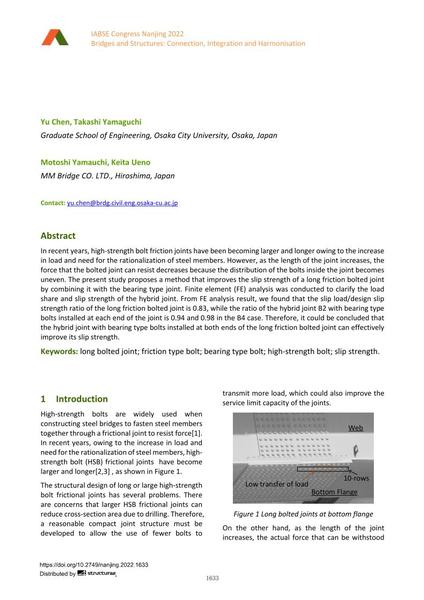Analytical Study on Slip Strength of Long Bolted Joint Combing with Bearing Type Bolts

|
|
|||||||||||
Détails bibliographiques
| Auteur(s): |
Yu Chen
(Graduate School of Engineering, Osaka City University, Osaka, Japan)
Takashi Yamaguchi (Graduate School of Engineering, Osaka City University, Osaka, Japan) Motoshi Yamauchi (MM Bridge CO. LTD., Hiroshima, Japan) Keita Ueno (MM Bridge CO. LTD., Hiroshima, Japan) |
||||
|---|---|---|---|---|---|
| Médium: | papier de conférence | ||||
| Langue(s): | anglais | ||||
| Conférence: | IABSE Congress: Bridges and Structures: Connection, Integration and Harmonisation, Nanjing, People's Republic of China, 21-23 September 2022 | ||||
| Publié dans: | IABSE Congress Nanjing 2022 | ||||
|
|||||
| Page(s): | 1633-1640 | ||||
| Nombre total de pages (du PDF): | 8 | ||||
| DOI: | 10.2749/nanjing.2022.1633 | ||||
| Abstrait: |
In recent years, high-strength bolt friction joints have been becoming larger and longer owing to the increase in load and need for the rationalization of steel members. However, as the length of the joint increases, the force that the bolted joint can resist decreases because the distribution of the bolts inside the joint becomes uneven. The present study proposes a method that improves the slip strength of a long friction bolted joint by combining it with the bearing type joint. Finite element (FE) analysis was conducted to clarify the load share and slip strength of the hybrid joint. From FE analysis result, we found that the slip load/design slip strength ratio of the long friction bolted joint is 0.83, while the ratio of the hybrid joint B2 with bearing type bolts installed at each end of the joint is 0.94 and 0.98 in the B4 case. Therefore, it could be concluded that the hybrid joint with bearing type bolts installed at both ends of the long friction bolted joint can effectively improve its slip strength. |
||||
| Copyright: | © 2022 International Association for Bridge and Structural Engineering (IABSE) | ||||
| License: | Cette oeuvre ne peut être utilisée sans la permission de l'auteur ou détenteur des droits. |
||||
